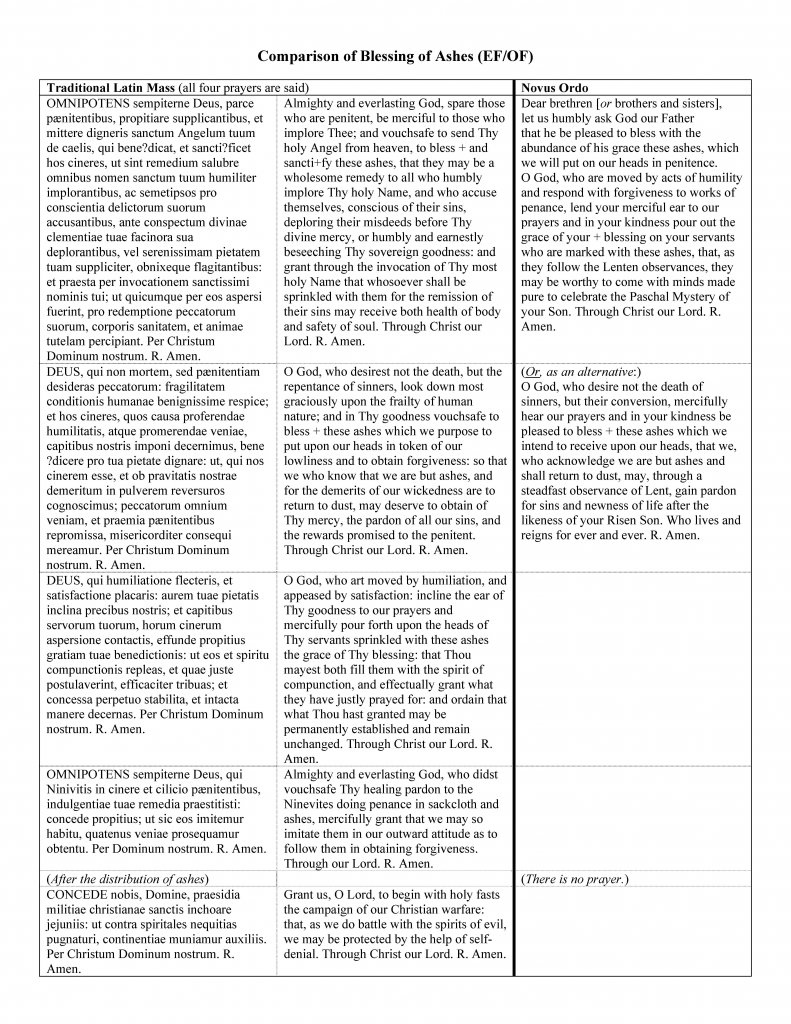From One Perter Five
By Dr Peter Kwasniewski
It’s on special days like today that I notice most sharply the vast difference between the LEX ORANDI of the old and the new liturgies.
I have prepared a chart comparing the blessing of ashes in the Tridentine rite with its parallel in the Novus Ordo.
(Click Image to Enlarge. Or download PDF version here.)
- There are five prayers said in the old rite (four before the imposition of ashes, one afterwards), compared with only one in the new (prefaced by a greeting, after which the priest is given an option between two prayers).
- The five traditional prayers strongly express the penitential spirit of the observance and the season (“spare those who are penitent”; “those who accuse themselves, deploring their misdeeds”; “demerits of our wickedness”; “the spirit of compunction”; “doing penance in sackcloth and ashes”; etc.) Such robust language is glaringly absent from the new prayers.
- Adverbs and adjectives emphasizing the seriousness and urgency of our prayers are abundant in the old rite (“humbly and earnestly beseeching Thy sovereign goodness”; “look down most graciously”; “mercifully pour forth”; “effectually grant what they have justly prayed for”; etc.). The new language — even with its 2011 improvement — is far weaker by comparison.
- The second option in the NO is similar to the second TLM prayer — but with this difference: the old prayer speaks of “the frailty of human nature,” “our lowliness,” “the demerits of our wickedness,” and “the rewards promised to the penitent”; all of this language is omitted from the new version of it.
- There is a spirit of militancy in the old: “Grant us, O Lord, to begin with holy fasts the campaign of our Christian warfare: that, as we do battle with the spirits of evil, we may be protected by the help of self-denial.” That is gone from the new.
- The old prayers refer to angels, good and evil: “vouchsafe to send Thy holy Angel from heaven…”; “do battle with the spirits of evil.” No such references remain in the new.
- In the old prayers, God is said to be “placated” with “satisfaction”: our works of penance, done in charity by His grace, win for us His pardon. The similar phrase “rewards of the penitent” point to the Catholic doctrine of merit, which is offensive to Protestants. The Ninevites are expressly mentioned in the fourth prayer. Language of placation, satisfaction, and merit, as well as the Ninevites, are notably absent in the new rite.
- In like manner, God is addressed twice as “Almighty and everlasting God” in the old rite; in the new, He is just “O God.”
- The old prayers refer to “health of body and safety of soul,” thus laying bare the totality of human nature in need of healing. This language is (again) absent from the new rite.
- The old prayers bless AND SANCTIFY the ashes (with three signs of the cross) so that they will be “a wholesome remedy to all who humbly implore Thy holy Name.” It is clear that the ashes are being made holy and given to us as a sacramental. While the new prayer does bless the ashes (unlike most of the “blessings” in the postconciliar Book of Blessings), it poorly signifies this aspect in word and gesture.
Add to these textual differences the following ceremonial ones:
- In the old rite, the priest prays these prayers at the high altar, facing east, wearing a violet cope, before the start of Mass. The old idea, which is far more striking, is to do the special thing first, before Mass begins—whether it be blessing candles, blessing ashes, blessing palms, or exchanging nuptial vows—and then to proceed into the Holy Sacrifice of the Mass bearing in our hands, on our heads, in our hearts, the special grace just given. It has a way of suffusing the entire celebration of Mass with the character of the feast or observance. In the new rite, the special thing pops up midway, after the homily. Instead of being the prism through which the light is shone, it becomes like the creamy center of the candy, which throws the whole liturgy off-balance.
- In the old rite, the priest sprinkles the ashes with holy water while reciting the Asperges me, and incenses them. The act of blessing the ashes is very clear. In the Novus Ordo, the priest sprinkles the ashes, “without saying anything” (as the rubrics put it: deliberately sticking it to the old practice).
- In the old rite, the faithful go up and kneel at the edge of the sanctuary, in a posture of humility, to have the ashes imposed on them from above. As with Holy Communion, the posture perfectly suits the meaning of what is being done. It is strange, to say the least, that in the Novus Ordo people can walk up in a queue and receive the ashes standing, in the posture of the resurrection, when the whole point of the ashes—as even the new prayers say—is to remind us that we are dust and shall return to dust. This, of course, is not nearly as bad a cognitive dissonance as queueing up to receive communion in the hand, standing, as if retrieving pre-ordered tickets.
These, ladies and gentlemen, are the kinds of difference you will find EVERYWHERE when you compare the two missals. The one is our Catholic inheritance from many centuries of faith; the other was put together by a committee in the 1960s, acting on their own bright (or not so bright) pseudo-scholarly quasi-pastorally-motivated ideas. It’s the difference between thick and thin religion.

The difference between a Kleenex and a tapestry.
ReplyDeleteThank you for this.